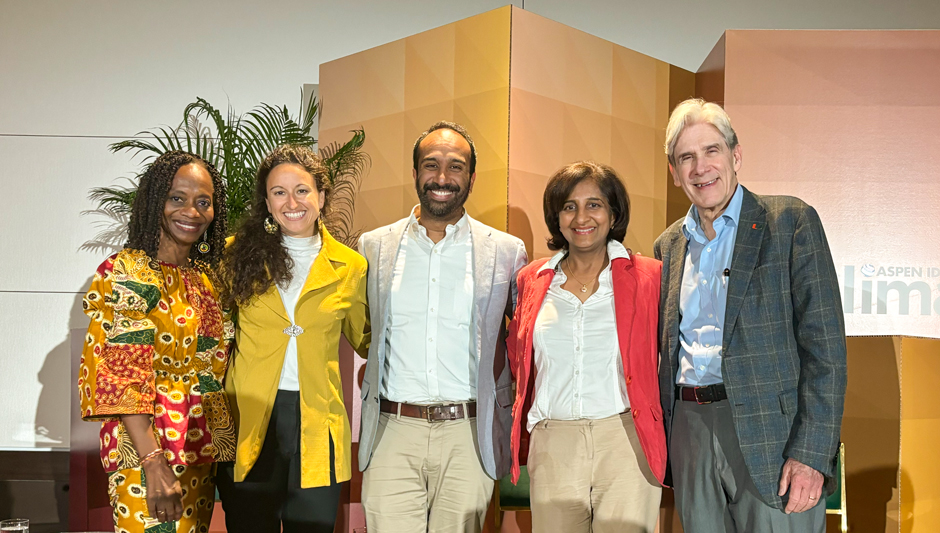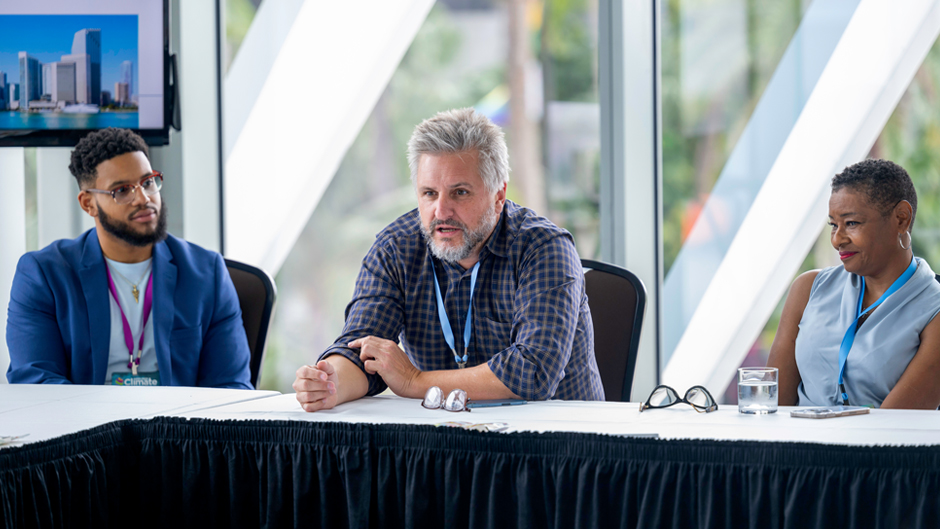Interactive city planning models that account for rising sea levels, a massive floating wind farm north of Ireland to help power Europe, and gene-editing technology to reduce methane emission from cows.
These were just a few of the concepts that leaders in government, science, and business were talking about to help people across the globe adapt to a warming climate during the Aspen Ideas: Climate conference in Miami Beach this week. University of Miami leaders, students, and faculty and staff members attended and joined many panels, along with hundreds of other students, alumni, scientists, entrepreneurs, as well as nonprofit and government leaders working in climate science.
“The topic of climate change is one that the University has enormous research and educational interest in, so Aspen Ideas: Climate is a great opportunity for us to highlight what we are doing in this area, and also to see what others are doing to build climate resilience,” said University President Julio Frenk.
During the conference, Frenk, a physician and public health expert, spoke at a session about health care and climate. Michael Berkowitz, executive director of the University’s Climate Resilience Academy, moderated two panels about how cities are preparing for the impacts of climate change. And Delaney Reynolds, a graduate marine science and law student, as well as a climate activist, spoke about her experience with environmental litigation, including a 2018 lawsuit she filed with others against Florida for not passing pollution restrictions that protect citizens’ health.

Frenk’s session, titled “How Healthcare can Heal People and Planet,” was moderated by Emmie Mediate of Health Care Without Harm, who explained an interesting predicament of the health care sector. While health care professionals often treat patients who are victims of climate change, such as extreme heat, chronic conditions exacerbated by air pollution, and victims of natural disasters, the sector as a whole contributes 8.5 percent of the United States’ carbon emissions.
“There’s an ironic role that health care is playing in the climate crisis. Its operations are contributing significantly to climate change and harming the very patients and communities that they are seeking to heal,” she said. “If the global health care community were a country, it would be the fifth largest greenhouse emitter on the planet.”
Many of the health care professionals on the dais had started or gotten involved in organizations to decrease waste in their hospitals, or to recognize the dangerous connections between health and climate. Gaurab Basu, director of education and policy at the Harvard T.H. Chan School of Public Health, said he realized just how much health and climate are related when he treated a patient from El Salvador, who had labored as a farmworker for 15 years and came in complaining about shortness of breath. After testing, Basu learned the young father was actually suffering from acute renal failure because of the heat’s impact on his body.
Frenk said recognizing the impacts of climate on health as well as the inequality of the health care system should be part of medical school curriculum today. And training anyone who works in health care to understand this is critical.
“If health care is the largest sector of our economy, we need to make climate scientists part of that sector,” he said. “We also need to reach across to professions who are not trained in health care, but who work in it and understand things like urban resilience and ecological science, to make sure our health care system is sustainable and that health care clinicians also have these competencies to address climate-related problems.”
Meanwhile, Berkowitz’s two sessions focused on how cities are building resilience to climate change. In the first panel, titled “Cities on the Front Lines of Climate Migration,” Berkowitz explained the widespread nature of this issue.
“Climate migration is going to be and is already a critical issue both for South Florida, the Americas and globally,” he said. “It is estimated that by 2050, climate impacts will displace 1.2 billion people. So that’s one out of every eight people on earth.”
During the second session, “Financing the Future: When Cities Set the Global Agenda,” the city of Jacksonville, Florida, was featured prominently. As one of the largest municipalities in the U.S. with 22 miles of beaches, Mayor Donna Deegan and chief resiliency officer Anne Coglianese are working with developers to plan ahead and encourage housing and infrastructure be built in higher, drier locations.
“Half of the city is still undeveloped, so we are trying to be strategic about where and how we are building,” Coglianese said.
While Berkowitz attended dozens of panels, he noted that climate migration remains a key issue, and said another topic that came up several times was how companies will show the cost benefits of green innovations.
“For example, we know that ocean biodiversity is good, but how good is it, and how do we understand that in terms of pricing it? How do we attach economic benefit to biodiversity? If we can do that, the market will fund it and you can get loans and bonds to finance it,” he said. “That will likely be the leading edge in our efforts to transform communities.”

